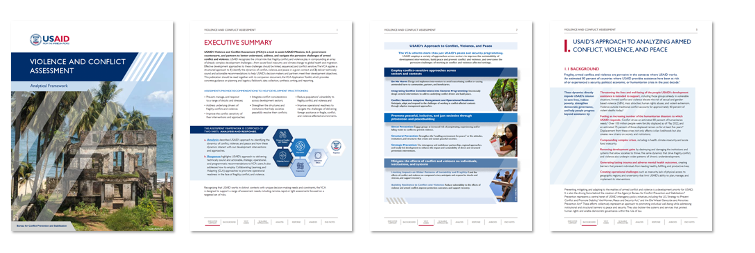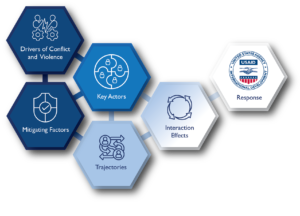USAID’s Violence and Conflict Assessment Analytical Framework: Visual engagement and learning through graphic design and accessibility
In daily life, we use simple visual information to complete tasks successfully. Illustrations and process graphics help us understand how to construct furniture, wash our hands effectively, and fold an origami crane, writes Sophie Sportiche, Principal Expert, Research, Evidence, and Analysis.
The international development sector often captures and shares information in extensive, text-heavy documents, which provide nuance and detail but are time-consuming to read. Applying simple visualization and design to narrative documents enables users to understand, navigate, and remember complex information more easily, enhancing our ability to learn and apply evidence to our work.
Understanding armed conflict and violence
Through the Peacebuilding, Evaluation, Analysis, Research, and Learning (PEARL) mechanism, Integrity recently led the graphic design and production of USAID’s Violence and Conflict Assessment (VCA) Analytical Framework to help readers engage with key concepts and approaches in understanding armed conflict and violence. The VCA analytical framework, which was developed by the Center for Conflict and Violence Prevention (CVP) at USAID, replaces the Conflict Assessment Framework 2.0. It provides the foundation for how USAID, its partners, and the wider community of practice assess and manage the unique challenges and risks of working in complex operating environments. With an estimated 80% of USAID Missions operating in conflict-affected settings, the framework’s uptake across the Agency and its partners is a critical part of efforts to support peace, security, and other development objectives.
Visual engagement
Working closely with CVP, Integrity’s graphic design team developed the visual identity for the VCA analytical framework. The aim was to create a document rich with complex, detailed information that is engaging and easy to navigate, with key concepts and ideas conveyed clearly and memorably. To achieve this, the graphic designers and CVP collaborated to illustrate the six key components and steps of the VCA through a compelling graphic.
The colors and icons used in the graphic are repeated throughout the document to reinforce key ideas, concepts, and connections between different sections. Color-coded boxes distribute dense text and provide users with quick access to tips on process, definitions, and links to examples and insights. A navigation bar at the bottom of every page helps users move through the different sections of the framework.
Accessibility
To accompany the comprehensive framework document, Integrity collaborated with CVP to produce the VCA Fact Sheet and the VCA Analytical Framework Brief. These products summarize key components in visually engaging formats to facilitate dissemination.
In addition, our graphic designers produced the VCA analytical framework to be inclusive and accessible to diverse audiences across the development sector. Integrity’s team implements universal design principles throughout document production processes, aligns with the most current Accessibility Conformance Checklists put forth by the US Department of Health and Human Services, and ensures compliance with Section 508 of the 1998 Rehabilitation Act. This allows people with disabilities or diverse language and learning needs to leverage a variety of technologies to access the framework’s insights – for example, by enabling the document to be read aloud or translated into different languages.
What’s next
As part of our continued support to CVP on dissemination and uptake, Integrity is now working to make the visual approaches in the VCA analytical framework adaptable and accessible for potential users. This includes a suite of PowerPoint graphics that will enable USAID and VCA teams to visually represent research findings, link them to key concepts in the VCA analytical framework, and support their uptake.
Across our portfolio of projects, Integrity prioritises high-quality, thought leading content, which generates knowledge and action. We strive to make sure that our documents facilitate information uptake and sharing. We achieve this through a strong collaborative approach between Integrity’s in-house graphic designers and wider delivery teams. Please get in touch if you are interested in learning more about Integrity’s work on PEARL, or about our graphic design and communications offer.
Thanks to Devon Charles and Laura Manganello Marchetti from Integrity’s graphic design team, as well as Frank Gitro from Frankenstern, for their expert design and layout of the suite of VCA Analytical Framework products.


